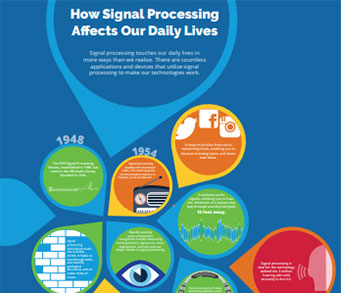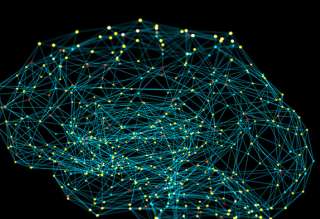SPS Feed
Top Reasons to Join SPS Today!
1. IEEE Signal Processing Magazine
2. Signal Processing Digital Library*
3. Inside Signal Processing Newsletter
4. SPS Resource Center
5. Career advancement & recognition
6. Discounts on conferences and publications
7. Professional networking
8. Communities for students, young professionals, and women
9. Volunteer opportunities
10. Coming soon! PDH/CEU credits
Click here to learn more.
The Latest News, Articles, and Events in Signal Processing
Graph distance (or similarity) scores are used in several graph mining tasks, including anomaly detection, nearest neighbor and similarity search, pattern recognition, transfer learning, and clustering. Graph distances that are metrics and, in particular, satisfy the triangle inequality, have theoretical and empirical advantages.
Control over noisy communication-channels” invented by Sahai-Mitter-and-Tatikonda is a prominent topic. In this context, the latency-and-reliability trade-off is considered by responding to the following: How much fast? How much secure? For a stochastic-mean-field-game (S-MFG), we assign the source-codes as the agents. Additionally, the total-Reward is the Volume of the maximum secure lossy source-coding-rate achievable between a set of Sensors, and the Fusion-Centre (FC) set – including intercepting-Byzantines.
In this paper, we investigate the challenging task of removing haze from a single natural image. The analysis on the haze formation model shows that the atmospheric veil has much less relevance to chrominance than luminance, which motivates us to neglect the haze in the chrominance channel and concentrate on the luminance channel in the dehazing process. Besides, the experimental study illustrates that the YUV color space is most suitable for image dehazing.
Video summarization is an important technique to browse, manage and retrieve a large amount of videos efficiently. The main objective of video summarization is to minimize the information loss when selecting a subset of video frames from the original video, hence the summary video can faithfully represent the overall story of the original video. Recently developed unsupervised video summarization approaches are free of requiring tedious annotation on important frames to train a video summarization model and thus are practically attractive.
With the help of convolutional neural networks (CNNs), video-based human action recognition has made significant progress. CNN features that are spatial and channelwise can provide rich information for powerful image description. However, CNNs lack the ability to process the long-term temporal dependency of an entire video and further cannot well focus on the informative motion regions of actions.
Scene text plays a significant role in image and video understanding, which has made great progress in recent years. Most existing models on text detection in the wild have the assumption that all the texts are surrounded by a rotated rectangle or quadrangle. While there also exist lots of curved texts in the wild, which would not be bounded by a regular bounding box.
Graph-based transforms have been shown to be powerful tools in terms of image energy compaction. However, when the size of the support increases to best capture signal dependencies, the computation of the basis functions becomes rapidly untractable. This problem is in particular compelling for high dimensional imaging data such as light fields. The use of local transforms with limited supports is a way to cope with this computational difficulty.
This paper proposes a multi-layer neural network structure for few-shot image recognition of novel categories. The proposed multi-layer neural network architecture encodes transferable knowledge extracted from a large annotated dataset of base categories. This architecture is then applied to novel categories containing only a few samples.
Anonymous authentication (AA) schemes are used by an application provider to grant services to its n users for pre-defined k times after they have authenticated themselves anonymously. These privacy-preserving cryptographic schemes are essentially based on the secret key that is embedded in a trusted platform module (TPM).
This article proposes an algorithm which allows Alice to simulate the game played between her and Eve. Under the condition that the set of detectors that Alice assumes Eve to have is sufficiently rich (e.g. CNNs), and that she has an algorithm enabling to avoid detection by a single classifier (e.g adversarial embedding, gibbs sampler, dynamic STCs), the proposed algorithm converges to an efficient steganographic algorithm.
The use of microwave tomography (MWT) in an industrial drying process is demonstrated in this feasibility study with synthetic measurement data. The studied imaging modality is applied to estimate the moisture content distribution in a polymer foam during the microwave drying process. Such moisture information is crucial in developing control strategies for controlling the microwave power for selective heating.
Perfusion computed tomography (PCT) is critical in detecting cerebral ischemic lesions. PCT examination with lowdose scans can effectively reduce radiation exposure to patients at the cost of degraded images with severe noise, and artifacts. Tensor total variation (TTV) models are powerful tools that can encode the regional continuous structures underlying a PCT object.
We consider the problem of localizing the source using range, and range-difference measurements. Both the problems are non-convex, and non-smooth, and are challenging to solve. In this article, we develop an iterative algorithm - Source Localization Via an Iterative technique (SOLVIT) to localize the source using all the distinct range-difference measurements, i.e., without choosing a reference sensor.
Personal Sound Zones (PSZ) systems aim to render independent sound signals to multiple listeners within a room by using arrays of loudspeakers. One of the algorithms used to provide PSZ is Weighted Pressure Matching (wPM), which computes the filters required to render a desired response in the listening zones while reducing the acoustic energy arriving to the quiet zones.
The study of label noise in sound event recognition has recently gained attention with the advent of larger and noisier datasets. This work addresses the problem of missing labels, one of the big weaknesses of large audio datasets, and one of the most conspicuous issues for AudioSet. We propose a simple and modelagnostic method based on a teacher-student framework with loss masking to first identify the most critical missing label candidates, and then ignore their contribution during the learning process.
We propose a novel modified Mel-discrete cosine transform (MMD) filter bank structure, which restricts the overlap of each filter response to its immediate neighbor. In contrast to the well-known triangular filters employed in the extraction of the Mel-frequency cepstral coefficients (MFCC), the proposed filter structure has a smoother response and offers discrete cosine transformation and Mel-scale filtering in a single operation.
This work examines a distributed learning problem where the agents of a network form their beliefs about certain hypotheses of interest. Each agent collects streaming (private) data and updates continually its belief by means of a diffusion strategy, which blends the agent’s data with the beliefs of its neighbors. We focus on weakly-connected graphs, where the network is partitioned into sending and receiving sub-networks, and we allow for heterogeneous models across the agents.
Recently, deep neural network (DNN) based methods for low-dose CT have been investigated to achieve excellent performance in both image quality and computational speed. However, almost all methods using DNNs for low-dose CT require clean ground truth data with full radiation dose to train the DNNs. In this work, we attempt to train DNNs for low-dose CT reconstructions with reduced tube current by investigating unsupervised training of DNNs for denoising sensor measurements or sinograms without full-dose ground truth images.
Regularization by denoising (RED) is an image reconstruction framework that uses an image denoiser as a prior. Recent work has shown the state-of-the-art performance of RED with learned denoisers corresponding to pre-trained convolutional neural nets (CNNs). In this work, we propose to broaden the current denoiser-centric view of RED by considering priors corresponding to networks trained for more general artifact-removal.
One challenging aspect in face anti-spoofing (or presentation attack detection, PAD) refers to the difficulty of collecting enough and representative attack samples for an application-specific environment. In view of this, we tackle the problem of training a robust PAD model with limited data in an application-specific domain.
Pages
SPS Social Media
- IEEE SPS Facebook Page https://www.facebook.com/ieeeSPS
- IEEE SPS X Page https://x.com/IEEEsps
- IEEE SPS Instagram Page https://www.instagram.com/ieeesps/?hl=en
- IEEE SPS LinkedIn Page https://www.linkedin.com/company/ieeesps/
- IEEE SPS YouTube Channel https://www.youtube.com/ieeeSPS









